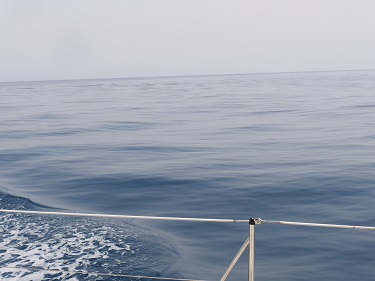23 to 24 July 2017
Scilla to Taormina, Sicily, N37° 51.0′ E15° 18.014, 35nm, 7 hours 30
to Catania, N37° 29.0′ E15° 06.0′, 22nm, 4 hours
The Messina Strait has filled sailors with fear since Homer wrote about Odysseus’ passage through it in The Odyssey and probably long before.
“all the sea was like a cauldron seething over intense fire, when the mixture suddenly heaves and rises.”
Myth and legend tell of Scilla as a giant sea monster, living in a cave at the mouth of the Strait, her 12 feet dangling down from the sheer cliffs and her 6 horrible heads reaching down to snatch seamen from their ships. On the other side of Strait was Charybdis, a giant whirlpool which swallowed ships whole.
In reality the Messina Strait is a narrow channel between the tip of Italy’s toe and Sicily. Only one and a half miles wide at its northern end it is where the warmer and less salty Tyrrhenian Sea meets the cooler and more salty Ionian Sea. This, coupled with the funnel effect of the geography on both water and wind, can mean strong tides and eddies, strong winds and those whirlpools that Homer wrote about. Oh! and a traffic separation scheme for big ships leaving little room for small boats like us to manoeuvre without doing the sailing equivalent of running across a motorway (1).
All this made us nervous!
We have not had to deal with tides since we navigated the Gibraltar Strait back in October. Finding information about the tidal flows through the Messina Strait was tricky. Online sources contradicted each other by several hours and we wanted to get this right. So, before he flew out to join us for our crossing to Greece, we consulted the best oracle we have on all things sailing, our friend, Martin!
Reassured we had the most accurate information and with a very benign weather forecast we set off to enter the Strait.
All was calm as we approached the tip of Italy’s toe and the narrowest point of the Strait. So far, no sea monsters!
If not sea monsters, one thing there is in the Messina Strait is swordfish and they are fished for in a very unusual way. Apparently swordfish “sleep” on the surface of the water and can therefore be easily snuck up upon. In order to do this local fishermen use boats with bowsprits of up to 20 metres and with an equally high mast from which the skipper can both steer the boat and spot unsuspecting fish to be harpooned by a crew member on the bowsprit. We saw this boat out fishing. It didn’t have the long bowsprit but the skipper was precariously perched at the top of its mast.
Turning the corner into the Strait and hugging the coast of the mainland we found these fishermen in tiny boats right at the place where the chart showed one of the potential whirlpools. With their local knowledge they were clearly happy there would be no whirlpools that day so we figured we should be ok.
By now we were starting to feel the effect of the wind and there was a strange choppiness in the sea state. Although the weather forecast was for less than 5 knots of wind, very quickly we had about 30 knots on our stern quarter and had a cracking downwind sail across the Strait to the Sicily side and were safely across the shipping lanes.

And as we got to the southern and wider end of the Strait the wind disappeared as quickly as it arrived and the water took on an eerie glassiness. Still no sea monsters, not even a swordfish.
We broke our journey to Catania with a night on mooring buoy in the bay beneath the town of Taormina, perched on a mountain ridge. Knowing we were heading for a week in a marina berth, we took this last opportunity for a while to swim. We can report that it is indeed true that the Ionian Sea is noticeably cooler than the Tyrrhenian! After the almost bath like temperatures of our recent anchorages, the water here was distinctly icy.

When the heat haze lifted after sunset we got our first sighting of Mount Etna, the volcano whose view would dominate our time in Sicily.
In the other direction, this was our view – cruise ships and super yachts of ridiculous sizes. One super yacht, owned by Microsoft’s co-founder, Paul Allen, had a sailing yacht as one of its many tenders and a helicopter complete with helicopter cover.
After a night in their company, with their cheesy underwater lights, we headed further south to Catania, in good time for Martin’s arrival and to explore a bit of Sicily…
Fen-notes
(1) small vessels should only cross a Traffic Separation Scheme (TSS) on a heading of 90°so as to cross it as quickly as possible










